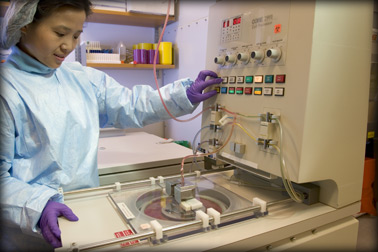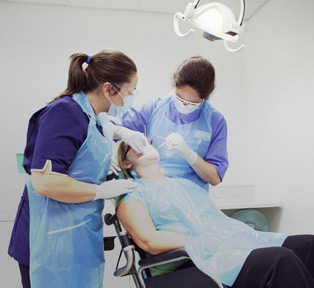|

Working mothers too can breastfeed
By Carol Aloysius
In spite of the enormous benefits of breastfeeding in terms of
reducing child mortality rates and increasing child survival rates of
those below five years, there are still many mothers who opt to switch
to formulae feeding once they return to work.
The common excuses for depriving their child of the best milk it can
have in the formative years of its life, are mostly related to issues
they face in their work places. They include, lack of separate baby
friendly rooms, and absence of baby care givers who could look after
their infants while they are at work.
 A recent discussion at the Health Education Bureau on the benefits of
breast feeding while highlighting the intrinsic value of exclusive
breastfeeding for six months of a child’s life, also brought to light a
disturbing fact; Many working mothers worldwide and in Sri Lanka
shortened the six months recommended by both the WHO and UNICEF to four
months once they completed their maternity leave. A recent discussion at the Health Education Bureau on the benefits of
breast feeding while highlighting the intrinsic value of exclusive
breastfeeding for six months of a child’s life, also brought to light a
disturbing fact; Many working mothers worldwide and in Sri Lanka
shortened the six months recommended by both the WHO and UNICEF to four
months once they completed their maternity leave.
The collective opinion of the speakers at this discussion was that
this decision on the part of working mothers could have drastic effects
on the new-born with life long adverse health impacts.
Consultant Community Physician Dr Dhammika Rowel, Family Health
Bureau was among several other health officials who made a strong case
for all working mothers continue to breastfeed.
In her presentation “Why working mothers can breastfeed’, she cited
WHO and UNICEF reports which stated that newborn deaths in the first 28
days which had now dropped dramatically due to improved health care and
interventions, now represent around 44 percent of all child deaths under
five years.
Most of these deaths were from preventable causes including
prematurely, childbirth complications and new born infections.
Immediate skin to skin contact and early initiation of breastfeeding
within an hour of birth could reduce b neonatal mortality significantly,
she said.
“Due to the endless benefits of breast milk in helping children to
have a good start in life, we must make sure that all working mothers
continue to breastfeed their babies even when they go back to work”, she
stressed. “Working mothers in Sri Lanka have excellent maternity
benefits with full pay and half pay and without pay if they wish. So
they should make use of these benefits if they want to ensure their
children receive optimal benefits from breast milk which is the best
milk a child can have,” she said.
But how, a question was raised.
“We need to educate working mothers of their rights and these
benefits. We need to also educate the heads of institutions of the
benefits of giving these mothers these rights and creating more baby
friendly surroundings for new mothers”, she replied.
Stressed
She also noted that when a mother goes back to work after her
maternity leave, she is often stressed and tense, and more likely to be
worried how her baby is being looked after at home while she's at work.
“My advice to them is, treat the first two weeks of returning to work
like the first two weeks post partum when mothers are stressed and
anxious unduly.
Relax.
Things may not always go smoothly. But the chances are you will
settle into a predictable rhythm.
Every mother can tailor-make her own program of how to feed her baby
with her own milk even when she's away at work, she pointed out.
This was by expressing her milk before she leaves for work, and
giving it to the caregiver to feed her child, while she’s away from
home.
"This will ensure the child gets his full quota of breast milk for
the scheduled six months. A working mothers knows at what time she needs
to be at her workplace in the morning, or whatever time she’s expected
to be there. So she must choose the time closest to her departure to
express her milk into a cup or cups, sufficient to last for the time
she’s away at work."
Q. Any guidelines on this procedure?
A. Leave yourself enough time to express the milk in a relaxed
way.
Express as much as you can into several cups and store in a cool
place.
* Leave about one cupful (100 ml) for each feed. Cover the cup and
store it in the coolest place or in a fridge. Invest in a fridge if you
can as it is the best place to store the milk.
Q. When is the right time to give baby its milk feed?
A. On demand. Whenever it cries.
Q. Should the milk be given straight from the fridge? Should
it be boiled?
A. I say NO to both questions. Before feeding, the care giver
must warm the milk by keeping it in a bowl of warm (not hot) water.
They must NOT reheat the milk either as heat destroys many of the
proactive factors that can benefit the child. And they should NOT re-use
milk that the baby has left over.
“Work according to your own time,” she advised mothers.
“That way you can exclusively breast feed your child for six months.
If for some very good reason you cannot do this, you may start the child
on complementary feeding with your doctor's advice.
But NO milk powder please! Even one bottle of artificial milk can
harm your child. Continue to express your milk and breast feed your
child when you return home. Each time you breast feed your baby; it
increases the volume of milk as suckling is more efficient than hand
expression.
Q. Any tips for mothers who may experience problems with
sudden leaks from an excess of breast milk while at work?
A. My advice is that they should express milk every three
hours.
Do this in whatever quiet place you can find. Keep a box of breast
pads to avoid leakages and spills! Stay hydrated. Keep a bottle of H2O.
Finally give yourself a plus point and congratulate yourself every
time you manage to go through another extra day of giving your child the
benefits of exclusive breast milk!
Q. Advice to parents and husbands?
A. For a working mother to achieve this goal of exclusive
breastfeeding for first six months of a child's life, she must have the
support of her husband and her extended family.
They must encourage her to do this for the sake of the child's
health.
They must recognise the rights of the child to enjoy the highest
attainable health. When a mother is in the hospital, many parents are
often in a hurry to take the mother back home even before breastfeeding
is properly established.
They must wait till the mother's milk starts flowing well and the
baby is sucking well, before the child is taken back home. This practice
must be continued and sustained for the next six months even after the
mother returns to work. The International Code of Marketing of Breast
milk substitutes has banned the distribution of free supplies of infant
formulae and samples to pregnant women, to encourage this habit.
Consultant Neonatologist, Dr Nishani Lucas in her presentation; ‘Why
should we breastfeed? said that the high literacy rates in the country
gave Lankan mothers an edge over mothers in the region since education
and literacy went hand in hand with promotion of health habits -
especially breastfeeding.
There were however knowledge gaps which needed to be identified and
filled among pregnant women.
“All mothers who come to our hospital at De Soyza Maternity Hospital
are counselled on the dangers of not breastfeeding their babies
immediately after birth and advised against giving their babies other
fluids.
We make it a point to ensure that even babies of disabled mothers who
are critically ill, paralysed, in the ICU, or after a Caesarian Section,
can still receive their mother’s milk by getting their care givers or
our own trained nurses to express the milk from the mother and feed it
to the baby in a cup.
Q. Do you allow bottle feeding of breast milk?
A. No. We never use bottles even to give breast milk to a
baby, since bottles can do more harm than good as they can become
contaminated and cause infections.
Nor do we give formulae milk unless we have absolutely no other
option. Almost all our babies including triplets have survived and are
in good health today because they have been fed with breast milk
exclusively for six months.
If however you were to visit a paediatric ward and look at the sick
children there today, you are likely to find that most of them have been
bottle fed with artificial milk. Our policy is No bottle feeding, No
teats and No pacifiers.
Consultant Community Physician, Family Health Bureau, Dr Hiranya
Jayawickrama, endorsing her views explained how Sri Lanka contributed to
achieving the ten Millennium Development Goals (MDGs).
These included: exclusive breast feeding for six months and continued
breastfeeding together with appropriate complementary feeding for two
years and beyond: achieving universal primary education for all children
by giving them a healthy start to life with breast milk: reducing infant
mortality rates (13 percent can be reduced with improved breast feeding
practices and 6 percent with improved complementary feeding:) preventing
malnutrition in under five year olds: decreasing maternal postpartum
blood loss, breast cancer, ovarian cancer, endometrial cancer and:
encouraging child spacing. She said even healthy mothers who have HIV
and are receiving treatment can now breast feed their babies as new
findings had shown that exclusive breast feeding together with
antiretroviral therapy for mothers and babies can significantly reduce
transmission of HIV from mother to child.
Our message is that, “Breast milk is the best and only milk a child
should have for the first six months to help him/her grow and develop
physically, mentally and emotionally”, she concluded.
Fighting HIV infection with the body's natural virus killers
Using the body's natural virus killers to prevent and treat HIV
infection has been problematic until now because of the strong
inflammatory response these molecules can arouse as they get rid of the
invaders.
 Now, collaborative research conducted by scientists have demonstrated
how suppressing the activity of these molecules - interferons - around
the time of infection could have long-term implications for the course
of the disease. Now, collaborative research conducted by scientists have demonstrated
how suppressing the activity of these molecules - interferons - around
the time of infection could have long-term implications for the course
of the disease.
Interferons, named for their ability to “interfere” with viral
replication, protect us against disease, but they are also the source of
inflammation when we are sick. Today, interferons are used to treat such
viral diseases as hepatitis.
But in HIV, it has been thought that the inflammation and other side
effects could be too harmful and the danger of a “runaway” immune
response too great. Prof. Gideon Schreiber and team, including
postdoctoral fellow Dr. Doron Levin and former postdoc Dr. Ganit Yarden,
had, in previous research, designed an antagonist molecule that is able
to block some of the activities of interferons while still allowing them
to proceed to act against viruses. Their original motivation, says
Schreiber, was to better understand the mechanisms of different versions
of the interferon molecule.
This research revealed that that the activity of each interferon is
tuned to specific cells and viruses. The molecule they had created, says
Schreiber, “was not a true ‘antagonist’ in the biological sense: instead
of blocking all IFN activity, it was able to target the mechanisms
leading to prevention of replication and modulation of the immune
system, leaving the antiviral activity mostly intact.”
Next, Schreiber and his group teamed up with Dr. Netanya Sandler and
Prof. Daniel Douek at the NIH to understand what happens when full-out
interferon activity is tampered with in HIV.
The research was done on simian immunodeficiency virus (SIV) - the
animal equivalent to HIV. Their results show that the actions blocked by
the molecule may have important functions,
even if they appear to be “detrimental.”
The team administered an antagonist, blocking a particular interferon
known as Type 1 IFN for the first four weeks after infection. Even after
this short period, they found that the natural immune system activities
did not recover and compensate to the level they otherwise would have;
and this led to a progression of the disease.
Schreiber: “These results clearly demonstrate the importance of an
early, general IFN response in fighting HIV infection, and removing the
‘harmful’ IFN functions even for just a short period at the onset of
infection can have devastating and permanent consequences in shaping the
course of disease.” Taken together, these findings suggest that not only
the type of treatment, but also the timing of IFN administration needs
to be considered in the management and prevention of disease.
- medicalxpress
Heat stroke can be life-threatening for endurance runners
Heat stroke is 10 times more likely than cardiac events to be
life-threatening for runners during endurance races in warm climates,
according to a new study.
 The authors noted the findings may play a role in the ongoing debate
over pre-participation ECG screenings for preventing sudden death in
athletes by offering a new perspective on the greatest health risk for
runners.Two of the most recognised causes of sudden death during an
endurance race are arrhythmic death, sudden death usually caused by
undetected heart disease in a young and seemingly healthy person, and
heat stroke; however, the authors noted sudden death from an undetected
heart condition often receives more attention from the medical community
and the media. The authors noted the findings may play a role in the ongoing debate
over pre-participation ECG screenings for preventing sudden death in
athletes by offering a new perspective on the greatest health risk for
runners.Two of the most recognised causes of sudden death during an
endurance race are arrhythmic death, sudden death usually caused by
undetected heart disease in a young and seemingly healthy person, and
heat stroke; however, the authors noted sudden death from an undetected
heart condition often receives more attention from the medical community
and the media.
Due to the increasing popularity of races over 10 km (6.2 miles), or
endurance races, researchers sought to determine how many
life-threatening events during endurance races were caused by heat
stroke compared to cardiac events.
A life-threatening event was defined as an event requiring mechanical
ventilation and hospitalisation in an intensive care unit. Researchers
reviewed data on all deaths and urgent hospitalisations at 14 popular
long-distance races in Tel Aviv from March 2007 to November 2013.
Overall, 137,580 runners were studied. Only two serious cardiac
events were reported during the time period and none were fatal or life
threatening.
In contrast, over the same period, there were 21 serious cases of
heat stroke, including two that were fatal and 12 that were
life-threatening. Under Israeli sports law, ECG screening is required
for participants who are organised in teams or associations, but not for
individuals in public endurance races.
Runners were only required to submit a personal statement confirming
a state of good health. Researchers, therefore, asked 513 runners who
were surveyed at the 2013 race whether they had undergone an ECG
screening. Only 35 percent reported an ECG in the previous year and 46
percent said they had an ECG in the previous five years, reducing the
possibility that the low number of cardiac events stemmed from at-risk
runners being screened out before the race.
- MNT
Stem cells from nerves form teeth
Researchers have discovered that stem cells inside the soft tissues
of the tooth come from an unexpected source, namely nerves. These
findings are now being published and contribute to brand new knowledge
of how teeth are formed, how they grow and how they are able to
self-repair.
 Our health and quality of life is closely linked to our dental
health. With age, our teeth become more susceptible to infection, wear
and damage, and it is important for the health services to help people
maintain good dental health. It was previously known that the living,
soft part of the tooth, or the pulp, in addition to connective tissues,
blood vessels and nerves also contains a small reserve of stem cells. Our health and quality of life is closely linked to our dental
health. With age, our teeth become more susceptible to infection, wear
and damage, and it is important for the health services to help people
maintain good dental health. It was previously known that the living,
soft part of the tooth, or the pulp, in addition to connective tissues,
blood vessels and nerves also contains a small reserve of stem cells.
These stem cells are capable of repairing the tooth when it has been
damaged by assisting the reformation of both hard and soft tooth tissue.
Researchers have long been discussing the origin of these stem cells. By
studying the teeth of mice, the researchers behind this new study have
been able to map the fate of individual cells.“We have identified a
previously unknown type of stem cells that surprisingly enough belong to
the nerves of the tooth; these are nerves that would normally be
associated with the tooth's extreme sensitivity to pain,” says Kaj Fried
at the Department of Neuroscience, one of the head researchers
responsible for the study.
The researchers discovered that young cells, which at first are part
of the neural support cells, or the glial cells, leave the nerves at an
early stage of the foetal development. The cells change their identity
and become both connective tissues in the tooth pulp and odontoblasts,
i.e., the cells that produce the hard dentin underneath the enamel.
Today we do not have the possibility of growing new teeth in adults, but
the discovery of this new type of stem cells is an important step
towards the knowledge and technology that is required to make it a
future possibility.
“The fact that stem cells are available inside the nerves is highly
significant, and this is in no way unique for the tooth.
- MNT
|

